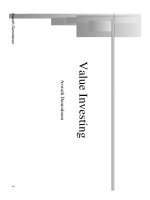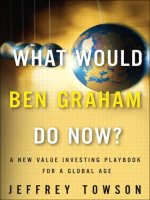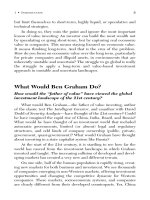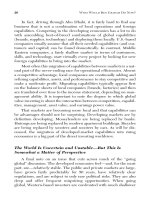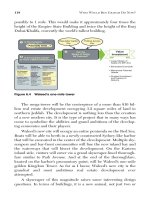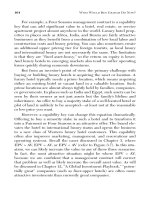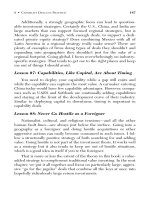value investing - aswath damodaran
Bạn đang xem bản rút gọn của tài liệu. Xem và tải ngay bản đầy đủ của tài liệu tại đây (200.65 KB, 43 trang )
Aswath Damodaran 1
Value Investing
Aswath Damodaran
Aswath Damodaran 2
Who is a value investor?
Q The Conventional Definition: A value investor is one who invests in
low price-book value or low price-earnings ratios stocks.
Q The Generic Definition: A value investor is one who pays a price
which is less than the value of the assets in place of a firm.
Aswath Damodaran 3
The Different Faces of Value Investing Today
Q Passive Screeners: Following in the Ben Graham tradition, you screen
for stocks that have characteristics that you believe identify under
valued stocks. Examples would include low PE ratios and low price to
book ratios.
Q Contrarian Investors: These are investors who invest in companies
that others have given up on, either because they have done badly in
the past or because their future prospects look bleak.
Q Activist Value Investors: These are investors who invest in poorly
managed and poorly run firms but then try to change the way the
companies are run.
Aswath Damodaran 4
I. The Passive Screener
Q This approach to value investing can be traced back to Ben Graham
and his screens to find undervalued stocks.
Q In recent years, these screens have been refined and extended. The
following section summarizes the empirical evidence that backs up
each of these screens.
Aswath Damodaran 5
A. Ben Graham’ Screens
1. PE of the stock has to be less than the inverse of the yield on AAA Corporate
Bonds:
2. PE of the stock has to less than 40% of the average PE over the last 5 years.
3. Dividend Yield > Two-thirds of the AAA Corporate Bond Yield
4. Price < Two-thirds of Book Value
5. Price < Two-thirds of Net Current Assets
6. Debt-Equity Ratio (Book Value) has to be less than one.
7. Current Assets > Twice Current Liabilities
8. Debt < Twice Net Current Assets
9. Historical Growth in EPS (over last 10 years) > 7%
10. No more than two years of negative earnings over the previous ten years.
Aswath Damodaran 6
How well do Graham’s screen’s perform?
Q A study by Oppenheimer concluded that stocks that passed the
Graham screens would have earned a return well in excess of the
market.
Q Mark Hulbert who evaluates investment newsletters concluded that
newsletters that used screens similar to Graham’s did much better than
other newsletters.
Q However, an attempt by James Rea to run an actual mutual fund using
the Graham screens failed to deliver the promised returns.
Q Graham’s best claim to fame comes from the success of the students
who took his classes at Columbia University. Among them were
Charlie Munger and Warren Buffett.
Aswath Damodaran 7
The Buffett Mystique
Figure 8.1: Berkshire Hathaway
$0.00
$200.00
$400.00
$600.00
$800.00
$1,000.00
$1,200.00
$1,400.00
$1,600.00
$1,800.00
1988 1989 1990 1991 1992 1993 1994 1995 1996 1997 1998 1999 2000 2001
Year
Value of $ 100 invested 12/88
Berkshire Hathaway
S&P 500
Aswath Damodaran 8
Buffett’s Tenets
Q Business Tenets:
• The business the company is in should be simple and understandable.
• The firm should have a consistent operating history
, manifested in operating
earnings that are stable and predictable.
• The firm should be in a business with favorable long term prospects
.
Q Management Tenets:
• The managers of the company should be candid. As evidenced by the way he
treated his own stockholders, Buffett put a premium on managers he trusted. •
The managers of the company should be leaders and not followers
.
Q Financial Tenets:
• The company should have a high return on equity. Buffett used a modified version
of what he called owner earnings
Owner Earnings = Net income + Depreciation & Amortization – Capital Expenditures
• The company should have high and stable profit margins.
Q Market Tenets:
• Use conservative estimates of earnings and the riskless rate as the discount rate.
• In keeping with his view of Mr. Market as capricious and moody, even valuable
companies can be bought at attractive prices when investors turn away from them.
Aswath Damodaran 9
Be like Buffett?
• Markets have changed since Buffett started his first partnership. Even
Warren Buffett would have difficulty replicating his success in today’s
market, where information on companies is widely available and dozens
of money managers claim to be looking for bargains in value stocks.
• In recent years, Buffett has adopted a more activist investment style
and
has succeeded with it. To succeed with this style as an investor, though,
you would need substantial resources and have the credibility that comes
with investment success. There are few investors, even among successful
money managers, who can claim this combination.
• The third ingredient of Buffett
’s success has been patience. As he has
pointed out, he does not buy stocks for the short term but businesses for
the long term. He has often been willing to hold stocks that he believes to
be under valued through disappointing years. In those same years, he has
faced no pressure from impatient investors, since stockholders in
Berkshire Hathaway have such high regard for him.
Aswath Damodaran 10
Value Screens
Q Price to Book ratios: Buy stocks where equity trades at less than or at
least a low multiple of the book value of equity.
Q Price earnings ratios: Buy stocks where equity trades at a low multiple
of equity earnings.
Q Price to sales ratio: Buy stocks where equity trades at a low multiple of
revenues.
Q Dividend Yields: Buy stocks with high dividend yields.
Aswath Damodaran 11
1. Price/Book Value Screens
Q A low price book value ratio has been considered a reliable indicator
of undervaluation in firms.
Q The empirical evidence suggests that over long time periods, low
price-book values stocks have outperformed high price-book value
stocks and the overall market.
Aswath Damodaran 12
Low Price/BV Ratios and Excess Returns
Lowest
2
3
4
5
6
7
8
9
Highest
1927-1960
1961-1990
1991-2001
0.00%
5.00%
10.00%
15.00%
20.00%
25.00%
PBV Class
Figure 8.2: PBV Classes and Returns - 1927-2001
1927-1960 1961-1990 1991-2001
Aswath Damodaran 13
Evidence from International Markets
Q Chan, Hamao and Lakonishok (1991) find that the book-to-market
ratio has a strong role in explaining the cross-section of average
returns on Japanese stocks.
Q Capaul, Rowley and Sharpe (1993) extend the analysis of price-book
value ratios across other international markets, and conclude that value
stocks, i.e., stocks with low price-book value ratios , earned excess
returns in every market that they analyzed, between 1981 and 1992.
Aswath Damodaran 14
Low PBV Effect in International Markets
Q Their annualized estimates of the return differential earned by stocks
with low price-book value ratios, over the market index, were as
follows:
Country Added Return to low P/BV portfolio
France 3.26%
Germany 1.39%
Switzerland 1.17%
U.K 1.09%
Japan 3.43%
U.S. 1.06%
Europe 1.30%
Global 1.88%
Aswath Damodaran 15
P/BV Ratios as Risk Proxies
Q Fama and French point out that low price-book value ratios may
operate as a measure of risk, since firms with prices well below book
value are more likely to be in trouble and go out of business.
Q Investors therefore have to evaluate for themselves whether the
additional returns made by such firms justifies the additional risk taken
on by investing in them.
Aswath Damodaran 16
Improving on the Price to Book Screen: Looking for
stocks with low Price to book and high ROE
Year Undervalued Portfolio Overvalued Portfolio S & P 500
1982 37.64% 14.64% 40.35%
1983 34.89% 3.07% 0.68%
1984 20.52% -28.82% 15.43%
1985 46.55% 30.22% 30.97%
1986 33.61% 0.60% 24.44%
1987 -8.80% -0.56% -2.69%
1988 23.52% 7.21% 9.67%
1989 37.50% 16.55% 18.11%
1990 -26.71% -10.98% 6.18%
1991 74.22% 28.76% 31.74%
1982-91 25.60% 10.61% 17.49%
Aswath Damodaran 17
2. Price/Earnings Ratio Screens
Q Investors have long argued that stocks with low price earnings ratios
are more likely to be undervalued and earn excess returns. For
instance, this is one of Ben Graham’s primary screens.
Q Studies which have looked at the relationship between PE ratios and
excess returns confirm these priors.
Aswath Damodaran 18
The Low PE Effect
Highest
2
3
4
5
6
7
8
9
Lowest
1952-71
1971-90
1991-2001
0.00%
5.00%
10.00%
15.00%
20.00%
25.00%
30.00%
Average Annual Return
PE Ratio Class
Figure 8.3: Returns on PE Ratio Classes - 1952 - 2001
Aswath Damodaran 19
More On the PE Ratio Effect
Q Firms in the lowest PE ratio class earned an average return
substantially higher than firms in the highest PE ratio class in every
sub-period.
Q The excess returns earned by low PE ratio stocks also persist in other
international markets.
Aswath Damodaran 20
The International PE Effect
Country Annual Premium earned by lowest P/E Stocks (bottom quintile)
Australia 3.03%
France 6.40%
Germany 1.06%
Hong Kong 6.60%
Italy 14.16%
Japan 7.30%
Switzerland 9.02%
U.K. 2.40%
Aswath Damodaran 21
3. Price/Sales Ratio Screens
Q Senchack and Martin (1987) compared the performance of low price-
sales ratio portfolios with low price-earnings ratio portfolios, and
concluded that the low price-sales ratio portfolio outperformed the
market but not the low price-earnings ratio portfolio.
Q Jacobs and Levy (1988a) concluded that low price-sales ratios, by
themselves, yielded an excess return of 0.17% a month between 1978
and 1986, which was statistically significant. Even when other factors
were thrown into the analysis, the price-sales ratios remained a
significant factor in explaining excess returns (together with price-
earnings ratio and size)
Aswath Damodaran 22
Composite Screens: Stocks with low price to sales
ratios and high margins
Year Undervalued Portfolio Overvalued Portfolio S & P 500
1982 50.34% 17.72% 40.35%
1983 31.04% 6.18% 0.68%
1984 12.33% -25.81% 15.43%
1985 53.75% 28.21% 30.97%
1986 27.54% 3.48% 24.44%
1987 -2.28% 8.63% -2.69%
1988 24.96% 16.24% 9.67%
1989 16.64% 17.00% 18.11%
1990 -30.35% -17.46% 6.18%
1991 91.20% 55.13% 31.74%
1982-91 23.76% 15.48% 17.49%
Aswath Damodaran 23
4. Dividend Yields
Highest
2
3
4
5
6
7
8
9
Lowest
1952-71
1971-90
1991-2001
0.00%
2.00%
4.00%
6.00%
8.00%
10.00%
12.00%
14.00%
16.00%
18.00%
20.00%
Average Annual Return
PE Ratio Class
Figure 8.4: Returns on Dividend Yield Classes - 1952 - 2001
Aswath Damodaran 24
Determinants of Success at Passive Screening
1. Have a long time horizon. All the studies quoted above look at returns
over time horizons of five years or greater. In fact, low price-book
value stocks have underperformed high price-book value stocks over
shorter time periods.
2. Choose your screens wisely: Too many screens can undercut the
search for excess returns since the screens may end up eliminating just
those stocks that create the positive excess returns.
3. Be diversified: The excess returns from these strategies often come
from a few holdings in large portfolio. Holding a small portfolio may
expose you to extraordinary risk and not deliver the same excess
returns.
4. Watch out for taxes and transactions costs: Some of the screens may
end up creating a portfolio of low-priced stocks, which, in turn, create
larger transactions costs.
Aswath Damodaran 25
II. Contrarian Value Investing: Buying the Losers
Q In contrarian value investing, you begin with the proposition that
markets over react to good and bad news. Consequently, stocks that
have had bad news come out about them (earnings declines, deals that
have gone bad) are likely to be under valued.
Q Evidence that Markets Overreact to News Announcements
• Studies that look at returns on markets over long time periods chronicle
that there is significant negative serial correlation in returns, I.e, good
years are more likely to be followed by bad years and vice versal.
• Studies that focus on individual stocks find the same effect, with stocks
that have done well more likely to do badly over the next period, and vice
versa.


